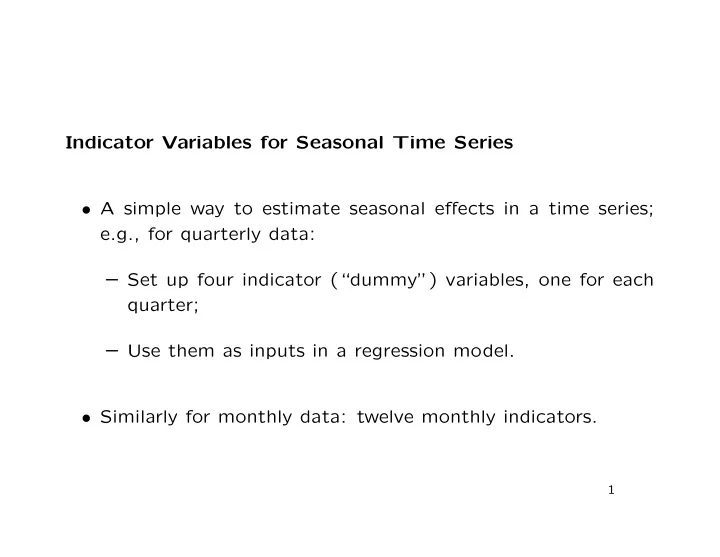

Indicator Variables for Seasonal Time Series • A simple way to estimate seasonal effects in a time series; e.g., for quarterly data: – Set up four indicator (“dummy”) variables, one for each quarter; – Use them as inputs in a regression model. • Similarly for monthly data: twelve monthly indicators. 1
• In R, you can create the indicators manually. – E.g., for a series x , Shumway and Stoffer suggest essen- tially: Q1 = rep(c(1, 0, 0, 0), length(x) / 4) etc. • You can then use lm() to fit the regression; – E.g., for the Johnson & Johnson quarterly earnings, fitting a linear trend and the quarterly indicators: summary(lm(log(jj) ∼ time(jj) + Q1 + Q2 + Q3 + Q4)) • For a monthly series, this would be tedious. 2
• R has some tools that can help: – If x is a seasonal time series (i.e., frequency(x) > 1 ), cycle(x) creates a companion time series whose value is the corre- sponding season. – E.g. cycle(jj) : Qtr1 Qtr2 Qtr3 Qtr4 1960 1 2 3 4 1961 1 2 3 4 1962 1 2 3 4 ... – Actually, does not need to be seasonal, but if x frequency(x) == 1 then all the values are 1 . 3
• The time series cycle(x) has quantitative values: plot(cycle(jj), xlim = c(1960, 1965)) 4.0 3.0 cycle(jj) 2.0 1.0 1960 1961 1962 1963 1964 1965 Time 4
• If you create a factor() from this time series and include it in the regression, lm() will see that it is a factor, and create one indicator variable for each level. – E.g., for the Johnson & Johnson quarterly earnings, fitting a linear trend and the quarterly indicators: Q = factor(cycle(jj)) summary(lm(log(jj) ~ time(jj) + Q)) gives (almost) the same output as if you used Q1 , Q2 , Q3 , and Q4 . – The difference is that when the model includes an inter- cept, one indicator needs to be omitted; for a factor, the first indicator is omitted, but for an explicit list of vari- ables, the last is omitted. 5
Lagged Variables • Time series models often include lagged variables. • You can use the R function lag() to construct them. • For example (using just the first five quarters’ earnings): > x = window(jj, end = 1961) > x Qtr1 Qtr2 Qtr3 Qtr4 1960 0.71 0.63 0.85 0.44 1961 0.61 6
> lag(x, k = -1) Qtr1 Qtr2 Qtr3 Qtr4 1960 0.71 0.63 0.85 1961 0.44 0.61 • Note that lag(x, k = -1) contains the same five values as x , but associated with different times. – For instance, the value 0.44 of lag(x, k = -1) for the first quarter of 1961 is 1960’s fourth quarter earnings (from x ). • The default is k = 1 , which changes the times the wrong way for most applications. 7
• Many R functions use the time structure of a series to “do the right thing”. • For example, plot(lag(x, -1), x, xy.labels = FALSE) plots each quarter’s earnings against the previous quarter’s: ● 0.8 0.7 x ● 0.6 ● 0.5 ● 0.5 0.6 0.7 0.8 lag(x, −1) 8
• Some functions do not ( lm() , lowess() ). • For these, you must first line up the data correctly, e.g., using cbind() : > y = cbind(x, lagx = lag(x, -1)) > y x lagx 1960 Q1 0.71 NA 1960 Q2 0.63 0.71 1960 Q3 0.85 0.63 1960 Q4 0.44 0.85 1961 Q1 0.61 0.44 1961 Q2 NA 0.61 9
• For example, if you wanted to include the prior quarter’s earnings into the regression for log earnings: jjdata = cbind(ljj = log(jj), tjj = time(jj), cjj = cycle(jj), lagljj = lag(log(jj), -1)) jjdata = data.frame(jjdata) jjdata$Q = factor(jjdata$cjj) summary(lm(ljj ~ tjj + Q + lagljj, data = jjdata)) • If you just include lag(log(jj), -1) in the original model, you get a very different result (try it!). 10
Recommend
More recommend